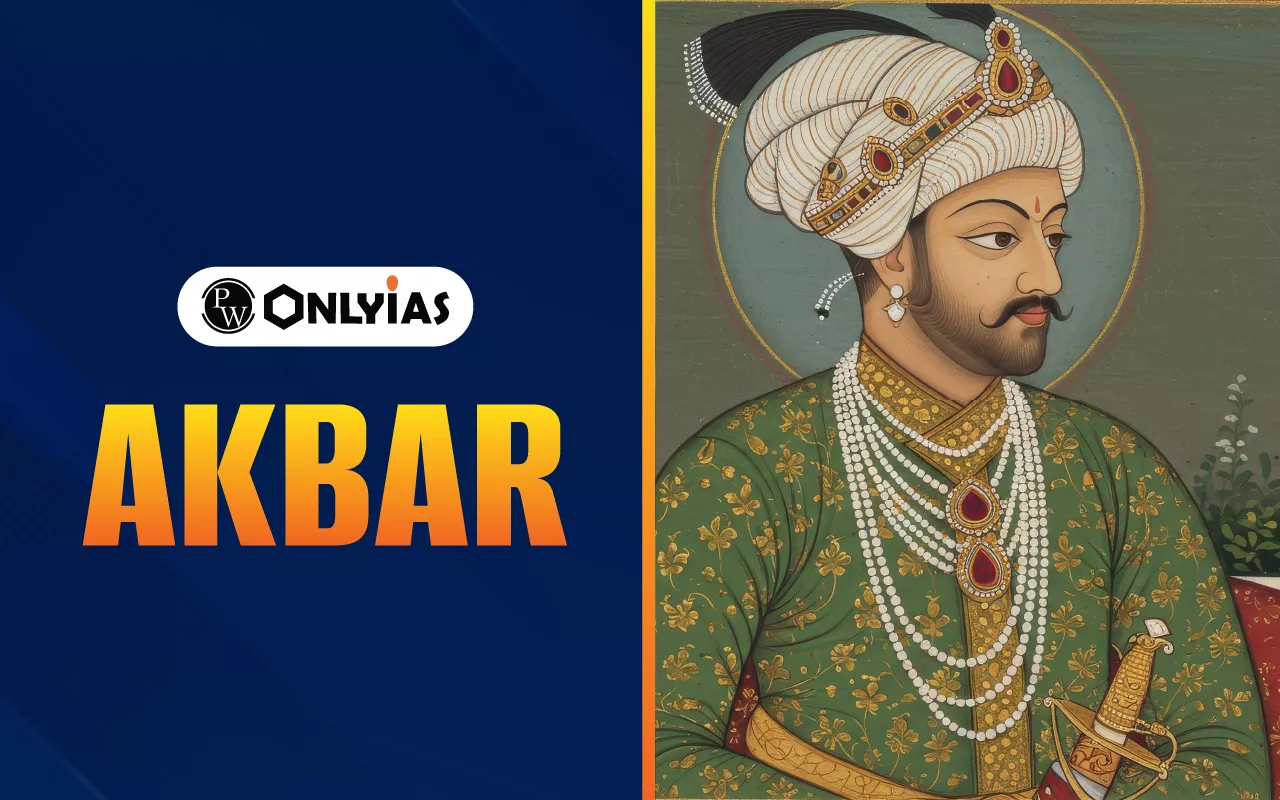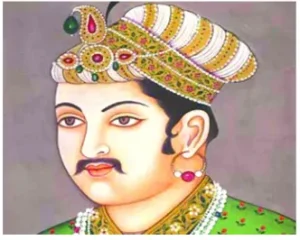Akbar, also known as Abu’l-Fath Jalal-ud-din Muhammad Akbar, ruled the Mughal Empire from 1556 to 1605. He expanded his territories through major battles, built strong administrative systems, was guided by his nine jewels, encouraged art and architecture, and left behind a remarkable legacy through buildings like Fatehpur Sikri and Agra Fort.

Akbar is considered one of the greatest kings in Indian history. He made his empire powerful through his bravery, sense of justice, and liberal thinking. Akbar Mughal emperor, did not just unite people with the sword but with his compassion, tolerance, and respect for all faiths. His reign is also known as the Golden Age of the Mughal Empire.
Akbar felt that the king should deal with all men as equals, regardless of their religion or creed. He had many wise men, poets, musicians, generals, and thinkers at his court to guide and counsel him and to help him in all matters of state. Under his rule, art, architecture, music, trade, and the military were at their peak.
Akbar was the third Mughal emperor. He was the grandson of Babur and the son of Humayun. He was born on 15 October 1542 in Umarkot in Sindh. He had a tumultuous childhood as his father had lost the throne and was a wanderer. As a result, he grew up as a brave, strong, and disciplined man. He was also intelligent and thoughtful.
Akbar did not know how to read and write. But he had a retentive memory and strong powers of observation. This made him wiser than most literate men of his time.

| Quick Facts about Akbar | |
| Information | Details |
| Akbar Full Name | Abu’l-Fath Jalal-ud-din Muhammad Akbar |
| Born | October 15, 1542, at Umarkot, Sindh |
| Father | Humayun |
| Mother | Hamida Banu Begum |
| Akbar Wife | Ruqaiya Sultan Begum, Salima Sultan Begum, Jodha Bai |
| Akbar Son | Prince Salim (later Emperor Jahangir) |
| Akbar Death | October 27, 1605, at Fatehpur Sikri |
| Buried | Akbar Jahan Tomb at Sikandra, Agra |
The life of Akbar is a journey from struggle to greatness. When Humayun regained the throne shortly before his death, Akbar became emperor at a very young age. He was only 13 when he sat on the Mughal throne.
Since he was too young to rule, Bairam Khan guided the empire in the early years. The turning point of Akbar’s biography came with the Second Battle of Panipat in 1556. This victory made Akbar the rightful and powerful ruler of North India.
Akbar later expanded his empire in many directions—Gujarat, Bengal, Kashmir, Sindh, Kabul, and the Deccan. He combined military strength with diplomacy. For example, he married the Rajput princess Jodha Bai, which improved harmony between Hindus and Muslims.
He spent time understanding various religions—Islam, Hinduism, Christianity, Sikhism, Jainism, and Zoroastrianism. To encourage peaceful debates, he built the Ibadat Khana in Fatehpur Sikri. Here, scholars from different religions came together to talk about ideas and beliefs.
His famous policy, Sulh-e-Kul (Peace for All), became a symbol of his tolerant and wise rule.
The Akbar family belonged to the Timurid-Mughal lineage. His grandfather, Babur, established the dynasty in India. His father Humayun was gentle and noble, but he faced many difficulties.
Akbar had deep respect for his mother, Hamida Banu Begum. Before every important decision or battle, he sought her blessings.
His marriage to Jodha Bai was politically and socially significant. Through this alliance, Akbar built trust with the Rajput rulers. His son Prince Salim, later known as Emperor Jahangir, continued the Mughal rule after Akbar’s death.
Akbar created one of the most efficient administrative systems in Indian history. His policies were practical, fair, and people-friendly.
He divided his empire into provinces called Subahs. Each Subah had a governor, known as a Subahdar. These were further divided into Sarkars and Parganas.
This system decided the rank, salary, and number of soldiers a person must maintain. It kept the military organized, disciplined, and loyal.
Raja Todar Mal introduced the Dahsala System, which fixed land revenue based on the average produce of 10 years. It protected farmers from exploitation.
Akbar established separate civil and criminal courts. He gave everyone equal opportunities to get justice.
His greatest contribution was Sulh-e-Kul, meaning universal peace. People were free to practice any religion without fear.
Akbar strengthened the army with cavalry, artillery, infantry, and elephants. Soldiers came from different communities, which also built unity.
He improved trade routes, built roads, and encouraged markets. This made the Mughal Empire wealthy and stable.
He built rest houses (sarais), hospitals, and schools, and made sure the people lived safely and peacefully
Akbar fought several battles to unite India. His victories came from strategy, courage, and military strength.
The most talented men of Akbar’s court were known as his Navratnas:
These 9 jewels helped Akbar in administration, culture, literature, music, and military affairs.
Akbar loved grand buildings and blended Indian, Persian, and Islamic styles beautifully. Some of the famous architectural works from his reign are:
His buildings reflect strength, beauty, balance, and innovation.
Check Out UPSC CSE Books
Visit PW Store
Akbar died on 27 October 1605 at Fatehpur Sikri after a brief illness. He was 63 years old. His body was placed in the magnificent Akbar Jahan Tomb at Sikandra, near Agra.
His death was deeply mourned, but his ideas would continue to influence the Mughal Empire under Jahangir and Shah Jahan.
Akbar’s reign is remembered for peace, prosperity and unity. He brought together people of different faiths and communities. His reforms in revenue, administration and military set India on a course that would last for centuries.
He showed that true leadership is not built by force, but by justice, compassion and understanding. Even today, the name Akbar stands for harmony, tolerance and wisdom.
Ready to boost your UPSC 2026 preparation? Join PW’s UPSC online courses today!
Akbar was one of the most powerful and celebrated Mughal emperors of India, reigning from 1556 to 1605. He was a brilliant administrator, military leader, and a man of religious tolerance.
The full name of Akbar was Jalal-ud-din Muhammad Akbar, but he is more famously known as Akbar the Great.
Akbar is referred to as “the Great” due to his powerful rule, expansion of his empire, just laws, and his respectful treatment of all religions. His reign was marked by peace, prosperity, and cultural development.
Akbar had numerous wives, including Ruqaiya Sultan Begum, Salima Sultan Begum, Mariam-uz-Zamani (Jodha Bai), among others. They were influential figures in the royal court.
Akbar’s son, Jahangir, succeeded him as the Mughal emperor. He continued many of Akbar’s policies.

<div class="new-fform">
</div>